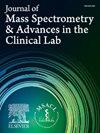MRM-based LC-MS method for accurate C-peptide quantitation
IF 3.4
4区 医学
Q2 MEDICAL LABORATORY TECHNOLOGY
Journal of Mass Spectrometry and Advances in the Clinical Lab
Pub Date : 2025-02-12
DOI:10.1016/j.jmsacl.2025.02.001
引用次数: 0
Abstract
Introduction
C-peptide secretion mirrors beta-cell function and has emerged as a valuable clinical biomarker for diabetes mellitus. C-peptide measurements can provide estimates of insulin secretory capacity, aiding in clinical decision-making and differentiation between diabetes types. Unfortunately, C-peptide assays are still not standardized, which may limit their practical clinical use. We have developed an MRM-based LC-MS method that demonstrated accuracy close to our reference method.
Objective
To develop and validate a mass spectrometry method for accurate quantitation of C-peptide.
Method
A serum sample was spiked with isotope-labeled C-peptide as a standard. The enrichment process involved protein precipitation with methanol, solid-phase extraction, and anion exchange for C-peptide enrichment followed by Glu-C digestion. The peptide LGGGPGAGSLQPLALE was quantitated using MRM in positive ion mode. The calibration process includes C-peptide CRM material to ensure a complete traceability chain for the measurement.
Results
The assay exhibited linearity across a wide range of C-peptide concentrations and a limit of quantitation of 0.058 nmol/L. The inter-day imprecision was less than 9.6 % CV, and the intra-day imprecision was less than 8.9 % CV. Spiking with bilirubin, triglycerides, and hemoglobin demonstrated no interference, except for triglycerides at very high levels. The method exhibited a strong correlation to the C-peptide reference method (r2 = 0.95).
Conclusion
The developed mass spectrometry method has demonstrated accurate results in C-peptide quantitation and can serve as a supplemental method to the existing C-peptide reference method. This ensures sustained stability over time and ultimately refines the existing reference system.
基于mrm的LC-MS方法用于c肽的准确定量
c肽分泌反映了β细胞的功能,已成为糖尿病的一种有价值的临床生物标志物。c肽测量可以提供胰岛素分泌能力的估计,帮助临床决策和区分糖尿病类型。不幸的是,c肽检测仍然没有标准化,这可能限制了它们的实际临床应用。我们开发了一种基于mrm的LC-MS方法,其精度接近我们的参考方法。目的建立并验证c肽的质谱测定方法。方法用同位素标记的c肽加标法测定血清样品。富集过程包括甲醇沉淀蛋白质、固相萃取、阴离子交换富集c肽,然后进行Glu-C消化。LGGGPGAGSLQPLALE肽在正离子模式下用MRM定量。校准过程包括c肽CRM材料,确保测量有完整的可追溯链。结果该方法在较宽的c肽浓度范围内呈线性,定量限为0.058 nmol/L。日间不精密度小于9.6% CV,日间不精密度小于8.9% CV。与胆红素、甘油三酯和血红蛋白一起注射没有干扰,除非甘油三酯水平很高。该方法与c肽参考方法具有较强的相关性(r2 = 0.95)。结论建立的质谱分析方法对c肽的定量结果准确,可作为现有c肽参比法的补充。这确保了随着时间的推移持续稳定,并最终完善了现有的参考系统。
本文章由计算机程序翻译,如有差异,请以英文原文为准。
求助全文
约1分钟内获得全文
求助全文
来源期刊

Journal of Mass Spectrometry and Advances in the Clinical Lab
Health Professions-Medical Laboratory Technology
CiteScore
4.30
自引率
18.20%
发文量
41
审稿时长
81 days
 求助内容:
求助内容: 应助结果提醒方式:
应助结果提醒方式:


